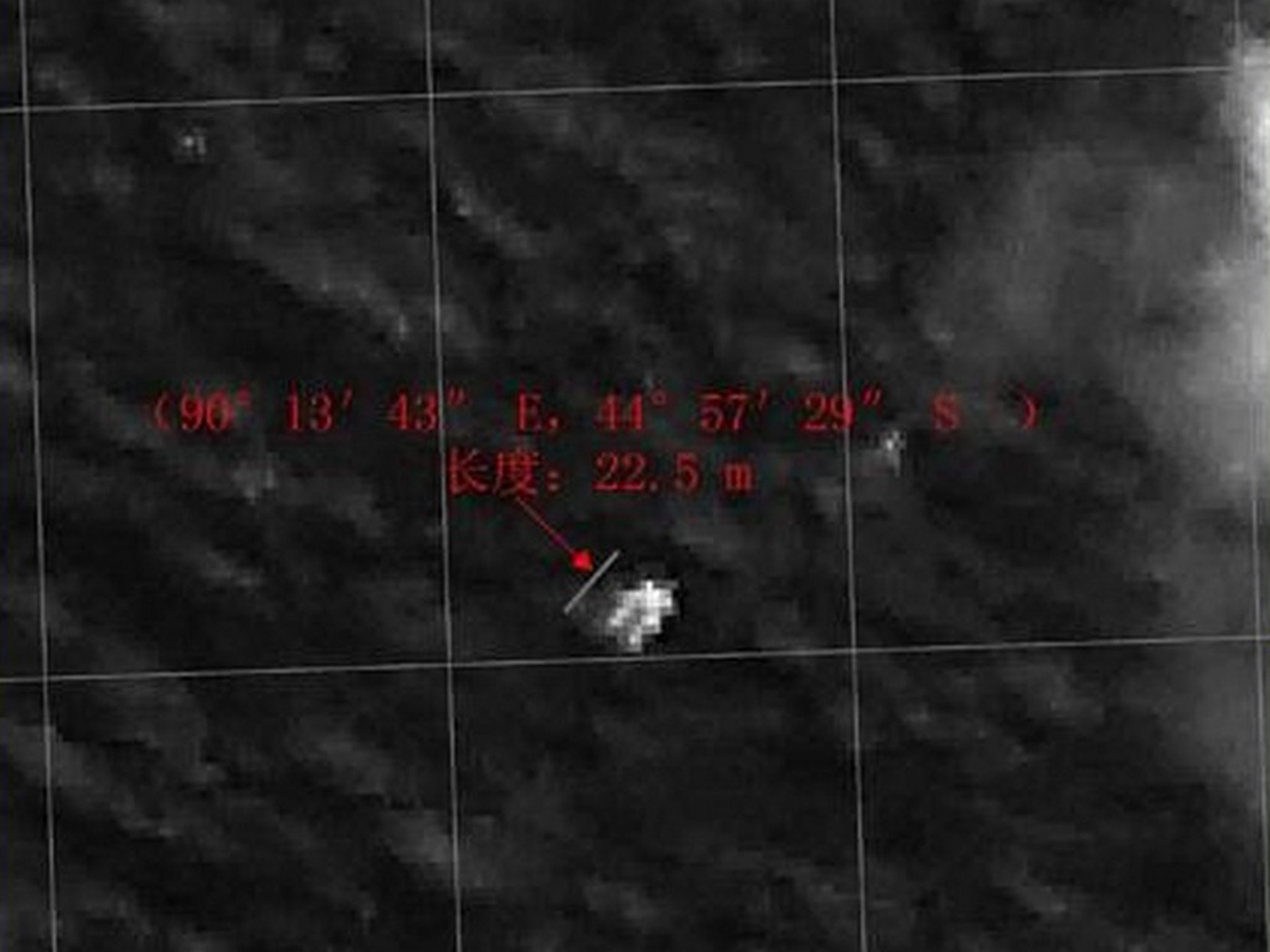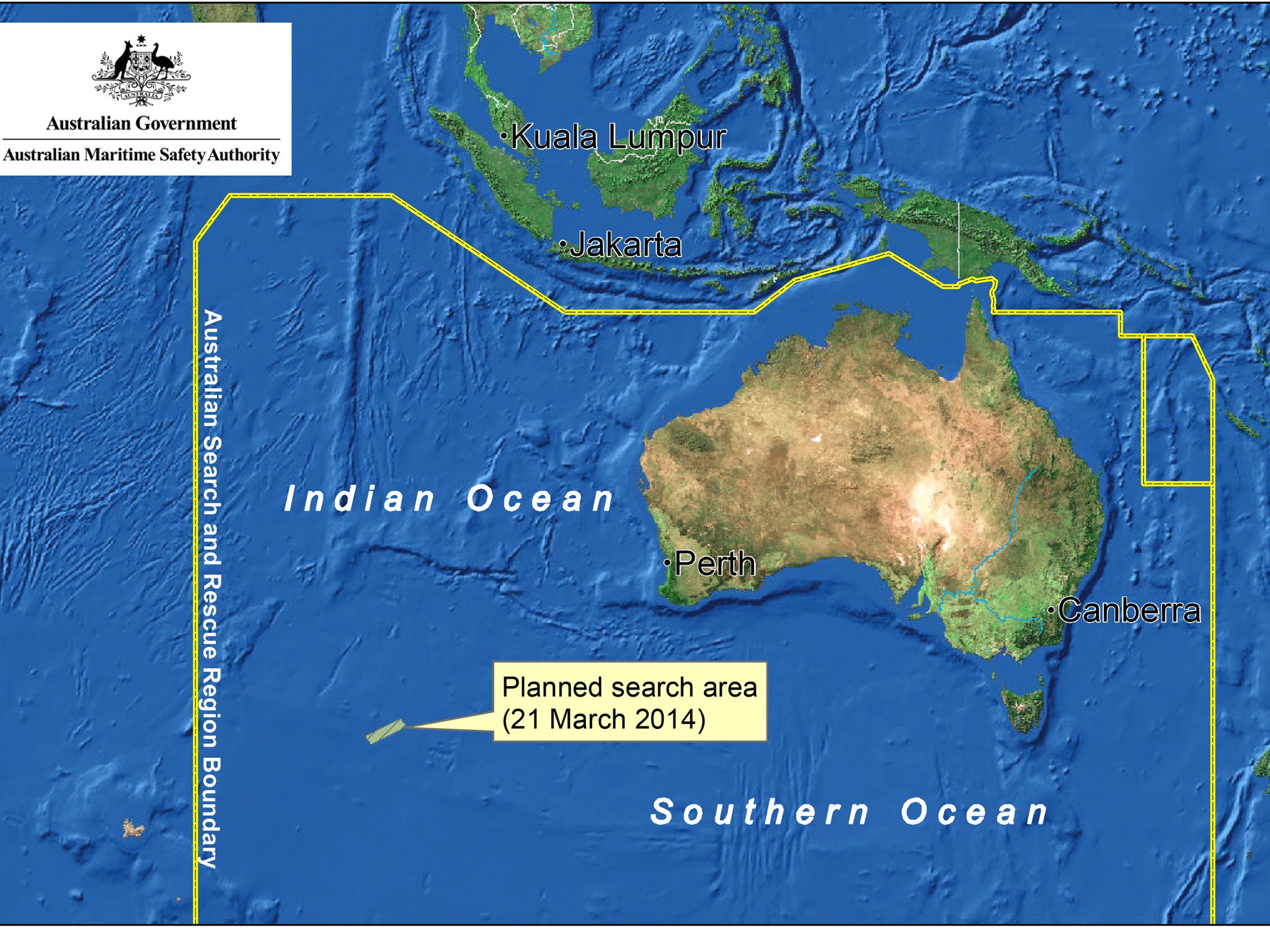Missing Malaysia Airlines Flight MH370: China reports new image of debris in the Indian Ocean
Chinese searchers spot possible debris in southern corridor, say Malaysian officials

Your support helps us to tell the story
From reproductive rights to climate change to Big Tech, The Independent is on the ground when the story is developing. Whether it's investigating the financials of Elon Musk's pro-Trump PAC or producing our latest documentary, 'The A Word', which shines a light on the American women fighting for reproductive rights, we know how important it is to parse out the facts from the messaging.
At such a critical moment in US history, we need reporters on the ground. Your donation allows us to keep sending journalists to speak to both sides of the story.
The Independent is trusted by Americans across the entire political spectrum. And unlike many other quality news outlets, we choose not to lock Americans out of our reporting and analysis with paywalls. We believe quality journalism should be available to everyone, paid for by those who can afford it.
Your support makes all the difference.A new lead has been dramatically introduced into the case of missing Malaysia Airlines Flight MH370, with China releasing a satellite image of what could be wreckage from the plane.
The grainy photograph showing a large object measuring 72ft by 43ft bolstered hopes that the southern Indian Ocean may yet yield clues to one of the biggest mysteries in modern aviation history.
The image’s release, and the investigation by the Chinese, was announced by Malaysia’s acting Transport Minister, Hishammuddin Hussein, after he was handed a note during a news conference in Kuala Lumpur. The image was captured by a Chinese satellite last Tuesday, two days after an Australian satellite spotted two objects, one of them a similar length to this latest object.
The new discovery was about 75 miles south of the original location – a distance which debris conceivably could have travelled in two days. Experts cautioned, though, that it remained a distinct possibility that both satellites had captured a lost shipping container, rather than a portion of the plane which disappeared off radar screens during an overnight flight from Kuala Lumpur to Beijing on 8 March.
Oceanographer Dr Simon Boxall of the University of Southampton said the object spotted by the Chinese satellite was unlikely to be the same as one of two objects highlighted by the Australian authorities as it would have had to have travelled against the prevailing current.
However, he said it was conceivable that all three pieces of debris were remains of the plane as they could have drifted that far apart in the two weeks since the plane went missing. This scenario, Dr Boxall said, was “not unlikely”.

Aircraft from Australia, New Zealand and US were joined by two military planes from China, which has also dispatched ships to the site about 1,500 miles south-west of Perth where the object was photographed by the high-definition Earth observation satellite Gaofen-1 on 18 March.
Speaking before the new satellite image was released, Warren Truss, Australia’s acting Prime Minister, warned that a comprehensive search could take a long time.
“It is a very remote area, but we intend to continue the search until we’re absolutely satisfied that further searching would be futile – and that day is not in sight,” he said in Perth, the staging post for search aircraft. “If there’s something there to be found, I’m confident that this search effort will locate it.”

The search is a challenging one, in an isolated location with strong currents and rough seas, and an ocean depth of up to 23,000ft. Mr Hussein noted that a low-level warning has been declared for a tropical cyclone approaching Australia, although it is currently to the country’s north.
The Transport Minister said he wanted to pay “special tribute to the men and women from all countries who are putting themselves in harm’s way in the search for MH370”, with some of the vessels joining the operation possibly having “to go through the cyclone to get to the [search] area”.
Pings sent by MH370 for several hours after it disappeared indicate that it ended up in one of two huge arcs: a northern corridor stretching from Malaysia to Central Asia, or a southern corridor extending towards Antarctica.
The British survey ship HMS Echo, which is equipped with sensitive underwater detection equipment, is on its way, but a Ministry of Defence spokesman said it would take more than 10 days to get to the southern corridor.
The Malaysian authorities believe the Boeing 777 veered drastically off course – with its communication systems disabled – as a result of deliberate action by someone on board. The most likely scenario, they say, was a hijacking, pilot sabotage or a sudden mid-air technical crisis.
The agony of families waiting to learn the fate of their loved ones spilled over again, with relatives angrily confronting Malaysian government and airline officials at a meeting in Beijing. The plane was carrying 153 Chinese passengers.
“You can’t leave here! We want to know what the reality is!” relatives shouted in frustration, before releasing a media statement saying they believed they were being “strung along, kept in the dark and lied to by the Malaysian government”.
Relatives of passengers on board Air France Flight AF447, which went missing on the way from Rio de Janeiro to Paris in 2009, urged the families of MH370 to demand an investigation by experts of their choice to “safeguard full transparency and best practices”. Bernd Gans, who lost a daughter, and Barbara Crolow, who lost her son, wrote in an open letter that the relatives should also demand financial aid from the Malaysian government.
Experts said families could seek compensation now. Floyd Wisner, a US lawyer who represented the families of Flight AF447, said that when a plane belonging to the Indonesian airline Adam Air disappeared in 2007, he secured a deal with the insurers before any trace of the plane was found. “The families may seek compensation even before any wreckage or bodies are found,” he? said.
“In the coming days there are likely to be more difficulties for the government and the people of Malaysia, more pain,” said Murray Hiebert, a South-east Asia expert at the Center for Strategic and International Studies in Washington. “In some senses, Malaysia and China may go through the grief the US experienced following the September 11 terrorist attacks, after which many bodies were never recovered.
“Obviously this is a disaster that Malaysia will carry in its national psyche. It will have to find a way to incorporate it into its narrative, and learn to live and move forward with the pain and loss, which won’t go away for a long time.”
Additional reporting by Ian Johnston
Costs to find MH370
As the days drag by without flight MH370 being found, the costs continue to mount.
The Malaysian acting transport minister, Hishammuddin Hussein, has stated that finding the missing jet is the most important priority, with costs not yet being considered – but eventually someone must foot the bill. The International Civil Aviation Organisation said the location of the accident will determine which country has jurisdiction. Over international waters, the state where the aircraft was registered, in this case Malaysia, must foot the bill.
The US has said it has already spent more than $2.5m (£1.5m) of the $4m it has set aside for the search, with other countries providing aircraft and ships.
The cost of finding the wreckage of Air France flight AF447 in the Atlantic in 2009 was €32m (£27m).
Chris Stevenson
Join our commenting forum
Join thought-provoking conversations, follow other Independent readers and see their replies
Comments